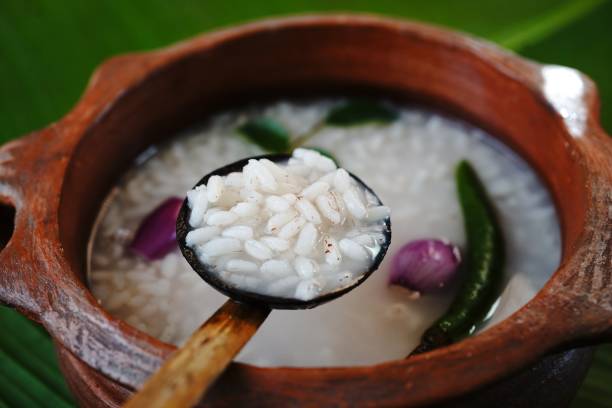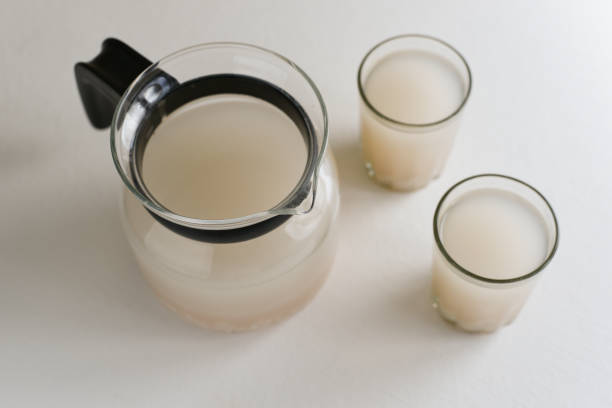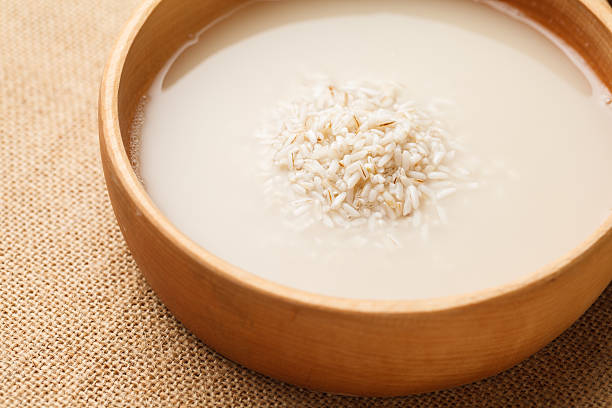Rice kanji is made from cooked rice soaked overnight in clay or mud pots. It is also called fermented rice . The fermentation of rice produces good gut bacteria, which is beneficial for gut health.

What is Rice Kanji (congee)?
Kanji rice, also called rice porridge or congee, is a simple dish made by cooking rice in a lot of water until it becomes soft and soupy. It’s easy to digest and is often eaten by people who are sick, kids, or anyone who wants a light meal.
In many cultures, rice kanji is a comfort food, sometimes served plain or with toppings like pickles or spices. It’s not just food—it’s also seen as a way to stay hydrated and get gentle nourishment.
Read More About (Rice kanji/congee)
Nutrition value of kanji rice (congee):
Here’s the approximate nutrition value of kanji rice (per 1 cup or ~240 ml serving, prepared with white rice):
| Nutrient | Amount (per 1 cup) | Comments |
|---|---|---|
| Calories | ~100-150 kcal | Low in calories, depending on rice type. |
| Carbohydrates | ~22-30 g | Primary source of energy. |
| Protein | ~2-3 g | Small amount of plant-based protein. |
| Fat | ~0.1-0.3 g | Very low in fat. |
| Fiber | ~0.5-1 g | Higher if made with brown rice. |
| Water | ~200-220 ml | High water content aids hydration. |
| Potassium | ~20-30 mg | Important for muscle and nerve function. |
| Magnesium | ~5-10 mg | Supports bone health and metabolism. |
| B Vitamins | Trace amounts | Include thiamine, niacin, and folate. |
Note:
The values may vary based on the type of rice (white, brown, or red) and the proportion of water used during preparation.
Benefits of rice kanji:
1. Improve gut health with fermented rice and probiotic drinks.
Digestive power has almost disappeared these days. A probiotic drink from rice kanji cools the stomach in hot weather and improves gut health. Its benefits will surprise you. One cause of poor digestion is a lack of good bacteria in the gut, which is very important for the digestion of food.
Probiotic drinks help increase good bacteria in the gut. Not just yogurt and rice kanji is also a good option for probiotic drinks, which can improve gut health.
Fermented rice is a gut-friendly food rich in probiotics, restores healthy intestinal flora, and can heal or prevent gastrointestinal problems such as duodenal ulcers, ulcerative colitis, Crohn’s disease, irritable bowel syndrome, celiac disease, and infections. It also helps prevent constipation and indigestion problems.
When rice is fermented, Lactobacillus bacteria grow in it, promoting a healthy microbiome in the gut.
Those who have weak digestion can get many benefits from drinking kanji rice water, and digestion improves.
Some more health benefits
2. Hydrates the Body: The high water content keeps you hydrated, especially in hot weather or during sickness.
3. Boosts Energy: The carbs in kanji provide a quick energy boost.
4. Good for Fever or Illness: Helps in recovery by providing simple nourishment without straining digestion.

How to Make Kanji Rice:
To make rice kanji, put some cooked rice in fresh water overnight. In the morning, you can eat this fermented rice. You can add curd to this rice. Kanji rice and curd rice are similar.
Step-by-step easy guidelines:
- Soak ½ cup of rice in ½ cup of water overnight.
- The next morning, transfer this rice to a blender and mix it smoothly. You can add salt if you want.
- Then, transfer the blended rice mixture to a bowl. Add some curd and sour yogurt to it and mix it well.
Now, take a seasoned pan and heat some coconut oil. Add mustard seeds, cumin seeds, and chopped green chili. Then add some chopped onion and fry this very well. Finally, add grated ginger and turn off your stove.
Put these things in your curd rice bowl and eat immediately. If you want, you can add some chopped coriander leaves. It increases the taste of kanji rice.
How to Make Probiotic Drink Kanji Rice Water:
First, put a spoonful of cooked rice in a glass and soak it overnight.
In the morning, add asafoetida, roasted cumin seeds, and black salt to this soaked water. This is how delicious rice kanji water is made.
Drink it on an empty stomach. This drink is very effective and provides relief for digestive problems.
Both of these ways of eating kanji rice are highly beneficial for our overall health.
Please comment below on how you feel after eating rice kanji and kanji rice water. And please subscribe to our newsletter to get more gut health-related tips and natural gut-friendly recipes.

Frequently Asked Questions
1. Is Kanji the same as congee?
Yes, kanji and congee are essentially the same dish, though the names vary depending on the region. Both refer to a rice porridge made by boiling rice in water until it becomes soft and soupy.
2. Does kanji help in weight loss?
Yes, kanji rice can support weight loss in certain situations. Kanji rice is light and low in calories, making it a good option for those looking to reduce their calorie intake without feeling too full or heavy.
3. Is congee eaten hot or cold?
Congee is usually eaten hot, as it’s a warm, comforting dish. However, some people enjoy it at room temperature or chilled, especially in warmer weather.
4. Is congee good for acid reflux?
Yes, congee can be good for acid reflux. It’s easy to digest, mild, and soothing on the stomach. The soft, watery texture helps avoid irritating the esophagus and can provide relief from discomfort. It’s best to keep it simple, without spicy or greasy toppings, to prevent triggering acid reflux.
5. How does rice kanji taste?
Rice kanji has a mild, slightly bland taste. It’s soft and watery, making it soothing and gentle on the stomach. The flavor is neutral, so it can easily be customized with toppings like salt, pickles, or spices for extra flavor. Some people enjoy it plain, while others prefer adding a little seasoning to enhance the taste.
6. Is kanji rice suitable for everyone?
Before eating kanji rice, you need to know a few things:
- If you have a sensitive stomach, it is not good to eat kanji rice. You can try a small amount and see how it reacts.
- If you have food allergy problems, then you should be cautious when taking kanji rice.
- If you have a lactose intolerance with dairy products, you can add lactose-free yogurt to your kanji rice.
References
1. Rice Fermentation and Gut Health
PubMed Article on Fermented Rice and Gut Microbiota
(Provides scientific backing for the benefits of fermented rice on gut health.)
2. Nutritional Benefits of Rice Porridge
Healthline – Nutritional Benefits of Congee
(Breakdown of macronutrients and additional health benefits.)
3. Probiotic Benefits of Fermented Foods
WebMD – Fermented Foods and Probiotics
(Explains the role of fermented foods like kanji in maintaining gut flora.)
4. Rice Porridge in Traditional Diets
Smithsonian Magazine – The Cultural History of Congee
(Provides historical context and cultural relevance of rice porridge globally.)
5. Traditional Ayurvedic Recipes
Ayurveda and Gut Health
(In-depth guide on Karkidaka Kanji and similar ayurvedic porridge recipes.)



